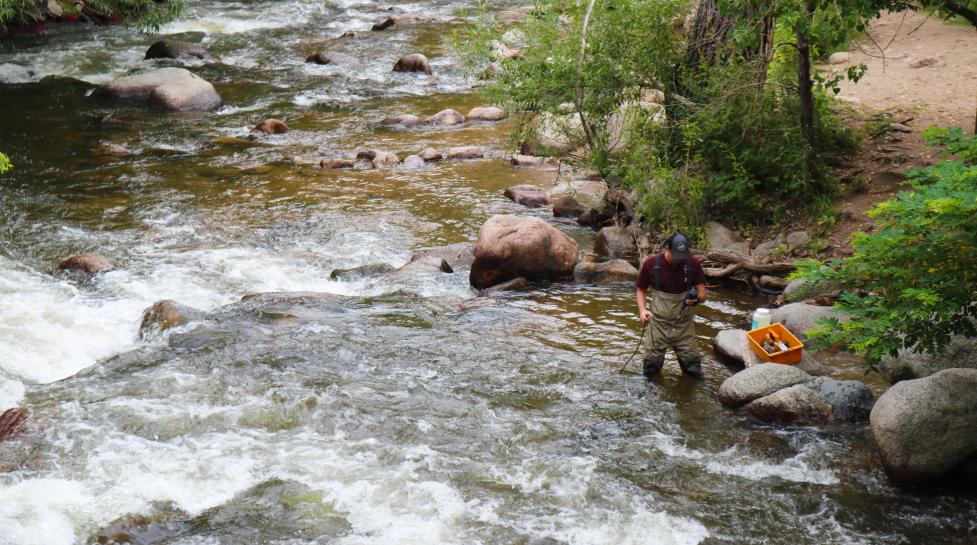The City of Boulder’s stormwater group conducts routine water quality and biological monitoring in Boulder Creek to evaluate current conditions, examine long-term trends, and gain a better understanding of the aquatic ecosystem of Boulder Creek.
E. Coli in Boulder Creek
Along with many streams on the Front Range and throughout Colorado, Boulder Creek is impaired for E. coli, meaning E. coli levels in Boulder Creek sometimes exceed the level deemed safe for recreational use by the U.S. Environmental Protection Agency. The city encourages the community to be aware of possible risks associated with recreating in Boulder Creek.
Reducing E. coli is a community-wide effort. Below are a few ways the city is working to address E. coli.
Safe Recreating Information
When wading or swimming in any natural water body, including Boulder Creek, you may be exposed to E. coli and other microorganisms. Most types of E. coli do not cause illness, but there are certain strains that can cause gastrointestinal illness and symptoms can include nausea, vomiting, stomachache, diarrhea, headache, and fever. Below are some tips to help reduce the chance of illness resulting from exposure to E. coli or other pathogens while swimming:
- Don’t get water in your mouth, eyes or open wounds
- Stay out of the water if you are sick or have a weakened immune system
- Wash your hands and shower after being in the creek
- Don’t swim within 48 hours of a rainstorm or if the water looks cloudy or discolored
- Be aware that small children and older adults may have more risk of contracting serious illness from waterborne pathogens
Four signs informing the public about safe practices when recreating in the creek were posted along the Boulder Creek Bike Path in July 2020.
What Is E. coli?
Escherichia coli (E. coli) are a large and diverse group of bacteria that typically live in the digestive tracks of warm-blooded animals. Most strains of E. coli are harmless, but some can make you sick.
Measuring for E. coli is easier than measuring for all possible pathogens in waterbodies, so it is widely used as an indicator of the presence of bacteria and viruses that can make people sick. Pathogens can originate from a variety of sources, including wildlife, pets, food and grease waste and illegal sanitary connections.
What Is the City Doing to Address E. coli?
Following the steps laid out in the 2019 E. Coli Total Maximum Daily Load (TMDL) Implementation Plan, the city is currently conducting outfall investigations to identify sources of E. coli in the storm sewer system leading to Boulder Creek. The city has completed investigations for five of the outfalls identified in the TMDL Implementation Plan. Results of these assessments have found that E. coli are dispersed and episodic throughout the stormwater system, with few direct or easily controllable sources. The city is currently using these findings to develop specific next steps for the program and will be shared on the city’s E. coli webpage by the end of 2024.
The city has monitored for E. coli in Boulder Creek for over 30 years and publishes results in the Keep It Clean Partnership’s water quality report. The next report will be issued in 2024. Staff continue to review data on an annual basis and have seen stable trends (that is, not increasing or decreasing) in E. coli levels over the past 10 years.
What is a Total Maximum Daily Load?
A Total Maximum Daily Load (TMDL) establishes the maximum amount of a pollutant a waterbody can receive without exceeding water quality standards. TMDLs are created for surface waters that are impaired due to prior exceedances of water quality standards and serve as a starting point or planning tool for restoring water quality.
The city developed the Boulder Creek E. coli TMDL in 2011 in response to the creek’s placement on the impaired waters list for bacteria.
The state Water Quality Standard for E.coli in recreational water bodies, including Boulder Creek, is 126 CFU/100 mL. Boulder Creek sometimes exceeds this standard. Levels of E. coli fluctuate frequently.
What you can do to help reduce bacteria pollution
- Pick up pet waste
- Reduce irrigation overspray
- Keep trash from wildlife
- Report spills like paint or chemicals, entering the street, storm drains or any water body
- Visit the Keep It Clean Partnership for tips to help reduce pollution
Learn more about E. coli on the city's website.
